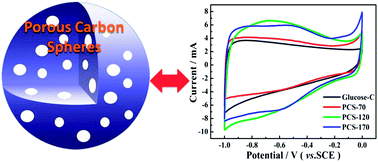Fabrication of porous carbon spheres for high-performance electrochemical capacitors†
Abstract
Porous carbon spheres (PCS) with meso/microporous structure are designed and fabricated through a facile hydrothermal method by employing glucose as a carbon precursor and sodium molybdate (Na2MoO4) as a porogen, structure-direct agent and catalyst. With the assistance of Na2MoO4, the porous structure of the carbon sphere is significantly enhanced. In addition, the meso/microporous structure can be modulated by adjusting the proportion of the reactants. In optimal conditions, the PCS exhibit a high specific surface area (SSA, 757.3 m2 g−1) and pore volume (0.24 cm3 g−1). When evaluated as an electrode for electrochemical capacitors, the PCS exhibits a high specific capacitance of 260 F g−1 with remarkable high-rate performance and long-term cycling stability. The excellent electrochemical performances are exclusively attributed to the micro/mesoporous structure, which maximize the ion accumulation on the electrode surface and facilitate fast ion transportation. The well-defined porous nanostructure plus easy strategy make current study provide new opportunities for hydrothermal carbonization of biomass as electrode materials for energy storage.


 Please wait while we load your content...
Please wait while we load your content...